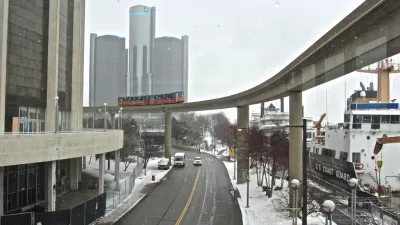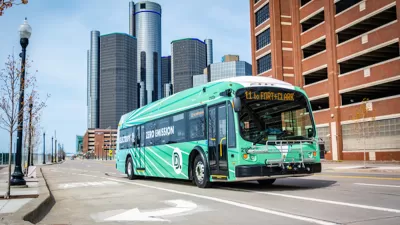A short guide to a few of Detroit's historic neighborhoods.

Last weekend, I was at the 24th Congress for the New Urbanism in Detroit. Near the end of the conference, I overheard someone saying: "I wish there was a guide to Detroit, like Lonely Planet or something." Even though I didn't see enough of Detroit to create a book-length guide, I think I saw enough for a blog post. So I thought I would write one.
I started off walking around downtown Detroit; downtown has apparently improved over the past few years, and seemed to me to be the most attractive part of the city. Although a few of the city’s historic office buildings are still unoccupied, many are now used either as offices or as residences, and others are clearly in the process of being rehabilitated. In addition, downtown has some interesting public spaces, most notably the Campus Martius park, which has a sandbox, a basketball court and other attractions. At the southern tip of downtown is the surprisingly blue Detroit River. On the negative side, the river is separated from the rest of downtown by Jefferson Avenue, a high-speed street (or stroad) with four lanes of traffic in each direction.
A few interesting neighborhoods are within walking distance (more or less) of downtown. The leafy Lafayette Park neighborhood, just east of downtown, is one of the better examples of mid-century "Towers in the Park" design; it includes both two-story townhouse units and high-rises designed by Mies Van Der Rohe. While mid-century construction is often unattractive, Lafayette Park's walkways and generous tree canopy actually make it seem parklike. On the negative side, I might be reluctant to live there if I lived in Detroit, because to get there from downtown, I walked through some blocks that seemed desolate even during the daytime.
Just northeast of downtown is an even more unusual area, Brush Park. This area is full of 19th-century Victorian mansions, only about a quarter of which survive. Because Brush Park deteriorated during the 20th century, much of the neighborhood is urban prairie—that is, some of the houses were destroyed, and their yards reverted to nature. But today, the neighborhood is being revitalized; some of the mansions are being rehabilitated, while once-empty blocks are filling up with new houses and condos. As a result, Brush Park is currently an interesting mix of progress and decay: some blocks are full of new houses, while others have a Victorian or two surrounded by prairie. I suspect that a decade or two from now, every inch of Brush Park will be inhabited. I wonder if the people who stay there till the 2030s will miss the old days of one or two houses per block.
A more conventional 19th-century neighborhood, Corktown, is about a 15 or 20 minute walk west of downtown. Corktown is dominated by small Victorian houses; my sense is that in 1900 it was a poorer area than Brush Park. Unlike Brush Park, it is mixed-use: our group did a Corktown pub crawl last week. On the negative side, the neighborhood’s main street, Michigan Avenue, is another of these huge streets that aren’t really much fun to cross, and the walk from downtown to Corktown involves some pretty desolate blocks. (I walked to Corktown before dark, but took a cab at night because those blocks gave me the willies.)
In addition to visiting areas within walking distance of downtown, I sampled local buses. I limited my urban bus use to the Woodward Avenue bus (bus 53), because the buses run every ten minutes during the day. By contrast, most Detroit buses seem to run much less frequently.
Woodward is another gigantic stroad, and is mostly bounded by poor areas. So if (unlike me) you are brave enough to explore lots of urban prairie, Woodward is as good a street as any to start with. But there are a few relatively prosperous areas off Woodward. Midtown Detroit, just north and west of Brush Park, includes a Whole Foods, a few new apartment buildings, most of the city’s museums, and Wayne State University. In addition, the more sterile New Center area north of Wayne State includes the Fisher Building (an art deco skyscraper/theatre) and numerous office buildings.
A few miles further north, just west of the 9300 block of Woodward, is the Boston-Edison historic district, full of 1920s mansions. (Henry Ford briefly lived in the neighborhood, at 140 Edison Avenue.) But unlike similar areas in more prosperous cities, Boston-Edison is not surrounded by walkable retail; instead, the retail near this area looks just like the rest of Woodward Avenue—that is, suburban and poor.
Still further north, at Seven Mile Road, is the Palmer Woods historic district—another wealthy 1920s area. Like Boston-Edison, Palmer Woods is not surrounded by walkable retail, and the area across Woodward from Palmer Woods looks quite distressed.
Ultimately, the Woodward Avenue bus terminates at a transit center at the city edge, where you can take buses to the suburbs (as I did one morning). The area has separate bus systems for the city and the suburbs; the Detroit Department of Transportation serves the city, and a separate agency called SMART serves the suburbs. The SMART bus I took (serving the suburb of Oak Park) runs every 45-60 minutes till about 10 PM. As a general matter,Detroit bus service seems roughly comparable to the much smaller area of Jacksonville,Florida (where I lived from 2006-11): bus routes serve a big chunk of suburbia, run into the evening but not until midnight, and tend to run every 30-60 minutes.

Manufactured Crisis: Losing the Nation’s Largest Source of Unsubsidized Affordable Housing
Manufactured housing communities have long been an affordable housing option for millions of people living in the U.S., but that affordability is disappearing rapidly. How did we get here?

Americans May Be Stuck — But Why?
Americans are moving a lot less than they once did, and that is a problem. While Yoni Applebaum, in his highly-publicized article Stuck, gets the reasons badly wrong, it's still important to ask: why are we moving so much less than before?

Using Old Oil and Gas Wells for Green Energy Storage
Penn State researchers have found that repurposing abandoned oil and gas wells for geothermal-assisted compressed-air energy storage can boost efficiency, reduce environmental risks, and support clean energy and job transitions.

Greening Oakland’s School Grounds
With help from community partners like the Trust for Public Land, Oakland Unified School District is turning barren, asphalt-covered schoolyards into vibrant, green spaces that support outdoor learning, play, and student well-being.

California Governor Suspends CEQA Reviews for Utilities in Fire Areas
Utility restoration efforts in areas affected by the January wildfires in Los Angeles will be exempt from environmental regulations to speed up the rebuilding of essential infrastructure.

Native American Communities Prepare to Lead on Environmental Stewardship
In the face of federal threats to public lands and conservation efforts, indigenous groups continue to model nature-centered conservation efforts.
Urban Design for Planners 1: Software Tools
This six-course series explores essential urban design concepts using open source software and equips planners with the tools they need to participate fully in the urban design process.
Planning for Universal Design
Learn the tools for implementing Universal Design in planning regulations.
Heyer Gruel & Associates PA
City of Moreno Valley
Institute for Housing and Urban Development Studies (IHS)
City of Grandview
Harvard GSD Executive Education
Salt Lake City
NYU Wagner Graduate School of Public Service
City of Cambridge, Maryland





























